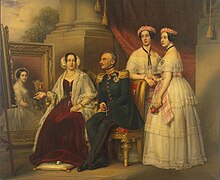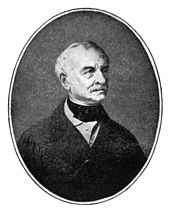Joseph (Saxony-Altenburg)

Joseph Georg Friedrich Ernst Karl of Saxony-Altenburg (born August 27, 1789 in Hildburghausen ; † November 25, 1868 in Altenburg ) was Duke of Saxony-Altenburg from 1834 to 1848 .
Life
Joseph was a son of Duke Friedrich von Sachsen-Hildburghausen (since 1826 Duke of Sachsen-Altenburg) and his wife Charlotte von Mecklenburg-Strelitz . His godparents were among others Emperor Joseph II. , Georg III. of Great Britain and King Friedrich Wilhelm II of Prussia .
The birth of the Hereditary Prince was greeted in Hildburghausen with the thunder of cannons and the Masonic Lodge minted a commemorative coin on this occasion. Joseph was raised by the Coburg court attorney Friedrich August Scheler. Traditionally, the prince learned the craft of a carpenter . In 1806 Joseph began his studies at the University of Erlangen at the request of his mother . On the occasion of the marriage of his sister Therese to the Bavarian Crown Prince Ludwig , he was accepted into the Order of Hubert in 1810 .
On January 9, 1814, Joseph was employed as a volunteer officer in the Prussian Army and assigned to Lieutenant General von Kleist . Together with his brother Georg he fought against France in the 1814 Wars of Liberation . As a major in the Guard Uhlan Regiment, Joseph retired from active service on August 19, 1816. In November 1849 he was appointed chief of the 19th Infantry Regiment and held the rank of General of the Infantry from May 31, 1859 . Joseph was also a Saxon major general.
On April 24, 1817, he married Duchess Amalie (1799–1848), daughter of Duke Ludwig von Württemberg, in Kirchheim under Teck .
Co-regent of his father since 1830, Joseph followed him after his death in 1834 as Duke of Saxony-Altenburg. On behalf of his father, he renewed the Duke of Saxe-Ernestine House Order in 1833 together with Dukes Ernst I of Saxe-Coburg and Gotha and Bernhard II of Saxe-Meiningen .
He carried out several buildings in Altenburg , including the Marstall building, a castle guard, which he had attached to the castle church in a similar style, and in 1841 he built a new princely crypt in the Altenburg cemetery. In 1839 the French palace park was transformed into an English landscape garden. The restoration of the Residenzschloss , begun under his father, was accelerated under Joseph.
Joseph ruled conservatively and unwilling to reform. The sessions of the state parliament were not open to the public and there was still compulsory guilds, which hampered industry and trade. Joseph favored ultra-church directions and in 1848 called imperial troops into the country because demands for a free state were loud. He finally had to resign from the government during the bourgeois revolution in 1848, which was unique in the Thuringian states. On November 30, 1848, two days after the death of his wife, he renounced the throne in favor of his brother George , since he had no sons .
In 1859 his son-in-law King George V bought him what was later to become the Altenburg Palace .
After his abdication, Joseph lived mainly at Castle Fröhliche Wiederkunft in Wolfersdorf . He thoroughly restored it and saved it from impending decay. Joseph supported artistic and scientific projects. At his expense, he had some paintings restored in the Altenburg town hall.
On June 30, 1866, after the battle of Langensalza, he received his son-in-law, the newly deposed King George V of Hanover , who went into his Austrian exile from here, at Castle Happy Return . Joseph was so closely connected to Wolfersdorf that his heart was buried here in his favorite place. In his will he had decreed: “ I wish to be buried as pompously as possible. The funeral oration should tell the truth, but serious care should be taken that no lying flatteries are shouted after me, which I always hated in my life and always protested against them. "

progeny
Joseph had six daughters with his wife Amalie:
- Marie (1818-1907)
- ⚭ 1843 King George V of Hanover (1819–1878)
- ⚭ 1852 Grand Duke Peter II of Oldenburg (1827–1900)
- Alexandra (1830-1911)
- ⚭ 1848 Grand Duke Constantine of Russia (1827–1892)
- Luise (1832-1833)
ancestors
| Pedigree of Joseph von Sachsen-Altenburg (1789–1868) | ||||||||
|---|---|---|---|---|---|---|---|---|
| Great grandparents |
Duke |
Duke |
Prince |
Prince |
||||
| Grandparents |
Duke |
Grand Duke |
||||||
| parents |
Duke Friedrich von Sachsen-Hildburghausen |
|||||||
|
Duke Joseph of Saxony-Altenburg (1789–1868) |
||||||||
literature
- Pasch .: Joseph (Duke of Saxe-Altenburg) . In: Allgemeine Deutsche Biographie (ADB). Volume 14, Duncker & Humblot, Leipzig 1881, p. 567 f.
- Heinrich Ferdinand Schoeppl: The dukes of Saxony-Altenburg. Bozen 1917, reprint Altenburg 1992
- Rudolf Armin Human: Chronicle of the city of Hildburghausen. Hildburghausen 1886.
- Kurt von Priesdorff : Soldier leadership . Volume 6, Hanseatische Verlagsanstalt Hamburg, undated [Hamburg], undated [1938], DNB 367632810 , pp. 136-137, no. 1759.
Web links
Individual evidence
- ^ Pasch .: Joseph (Duke of Saxe-Altenburg) . In: Allgemeine Deutsche Biographie (ADB). Volume 14, Duncker & Humblot, Leipzig 1881, p. 567 f.
| predecessor | Office | successor |
|---|---|---|
| Friedrich |
Duke of Saxony-Altenburg 1834–1848 |
George |
| personal data | |
|---|---|
| SURNAME | Joseph |
| ALTERNATIVE NAMES | Saxony-Altenburg, Joseph Georg Friedrich Ernst Karl von (full name) |
| BRIEF DESCRIPTION | Duke of Saxony-Altenburg (1834–1848) |
| DATE OF BIRTH | August 27, 1789 |
| PLACE OF BIRTH | Hildburghausen |
| DATE OF DEATH | November 25, 1868 |
| Place of death | Altenburg |
